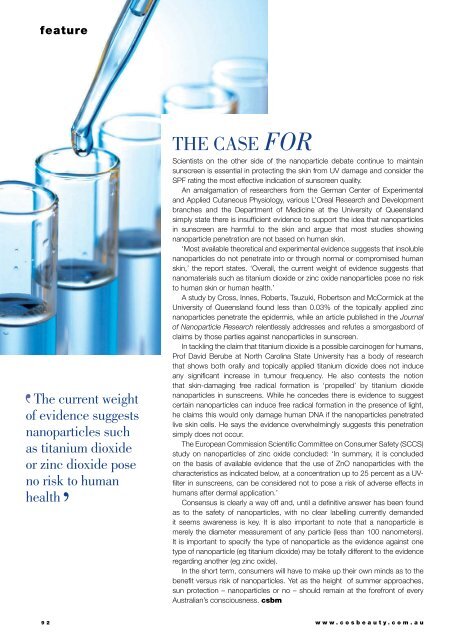Cosmetic Surgery and Beauty Magazine #66
Cosmetic Surgery and Beauty is the must-read for anyone considering a cosmetic procedure or treatment. With hundreds of before and after photo, and cosmetic and plastic surgery experts featured, tis educational resource will allow you to confidently decide the best course of action. This issue includes features on: Breast reshaping Six ways to get younger looking skin Surgical vs non-surgical fat reduction Body soothing products Energy boosters DIY perfect makeup As well as regular features on breast augmentation, facelifting, rhinoplasty and liposculpture/liposuction.
Cosmetic Surgery and Beauty is the must-read for anyone considering a cosmetic procedure or treatment. With hundreds of before and after photo, and cosmetic and plastic surgery experts featured, tis educational resource will allow you to confidently decide the best course of action.
This issue includes features on:
Breast reshaping
Six ways to get younger looking skin
Surgical vs non-surgical fat reduction
Body soothing products
Energy boosters
DIY perfect makeup
As well as regular features on breast augmentation, facelifting, rhinoplasty and liposculpture/liposuction.
Create successful ePaper yourself
Turn your PDF publications into a flip-book with our unique Google optimized e-Paper software.
feature<br />
The current weight<br />
of evidence suggests<br />
nanoparticles such<br />
as titanium dioxide<br />
or zinc dioxide pose<br />
no risk to human<br />
health<br />
The case for<br />
Scientists on the other side of the nanoparticle debate continue to maintain<br />
sunscreen is essential in protecting the skin from UV damage <strong>and</strong> consider the<br />
SPF rating the most effective indication of sunscreen quality.<br />
An amalgamation of researchers from the German Center of Experimental<br />
<strong>and</strong> Applied Cutaneous Physiology, various L’Oreal Research <strong>and</strong> Development<br />
branches <strong>and</strong> the Department of Medicine at the University of Queensl<strong>and</strong><br />
simply state there is insufficient evidence to support the idea that nanoparticles<br />
in sunscreen are harmful to the skin <strong>and</strong> argue that most studies showing<br />
nanoparticle penetration are not based on human skin.<br />
‘Most available theoretical <strong>and</strong> experimental evidence suggests that insoluble<br />
nanoparticles do not penetrate into or through normal or compromised human<br />
skin,’ the report states. ‘Overall, the current weight of evidence suggests that<br />
nanomaterials such as titanium dioxide or zinc oxide nanoparticles pose no risk<br />
to human skin or human health.’<br />
A study by Cross, Innes, Roberts, Tsuzuki, Robertson <strong>and</strong> McCormick at the<br />
University of Queensl<strong>and</strong> found less than 0.03% of the topically applied zinc<br />
nanoparticles penetrate the epidermis, while an article published in the Journal<br />
of Nanoparticle Research relentlessly addresses <strong>and</strong> refutes a smorgasbord of<br />
claims by those parties against nanoparticles in sunscreen.<br />
In tackling the claim that titanium dioxide is a possible carcinogen for humans,<br />
Prof David Berube at North Carolina State University has a body of research<br />
that shows both orally <strong>and</strong> topically applied titanium dioxide does not induce<br />
any significant increase in tumour frequency. He also contests the notion<br />
that skin-damaging free radical formation is ‘propelled’ by titanium dioxide<br />
nanoparticles in sunscreens. While he concedes there is evidence to suggest<br />
certain nanoparticles can induce free radical formation in the presence of light,<br />
he claims this would only damage human DNA if the nanoparticles penetrated<br />
live skin cells. He says the evidence overwhelmingly suggests this penetration<br />
simply does not occur.<br />
The European Commission Scientific Committee on Consumer Safety (SCCS)<br />
study on nanoparticles of zinc oxide concluded: ‘In summary, it is concluded<br />
on the basis of available evidence that the use of ZnO nanoparticles with the<br />
characteristics as indicated below, at a concentration up to 25 percent as a UVfilter<br />
in sunscreens, can be considered not to pose a risk of adverse effects in<br />
humans after dermal application.’<br />
Consensus is clearly a way off <strong>and</strong>, until a definitive answer has been found<br />
as to the safety of nanoparticles, with no clear labelling currently dem<strong>and</strong>ed<br />
it seems awareness is key. It is also important to note that a nanoparticle is<br />
merely the diameter measurement of any particle (less than 100 nanometers).<br />
It is important to specify the type of nanoparticle as the evidence against one<br />
type of nanoparticle (eg titanium dioxide) may be totally different to the evidence<br />
regarding another (eg zinc oxide).<br />
In the short term, consumers will have to make up their own minds as to the<br />
benefit versus risk of nanoparticles. Yet as the height of summer approaches,<br />
sun protection – nanoparticles or no – should remain at the forefront of every<br />
Australian’s consciousness. csbm<br />
92 www.cosbeauty.com.au

















